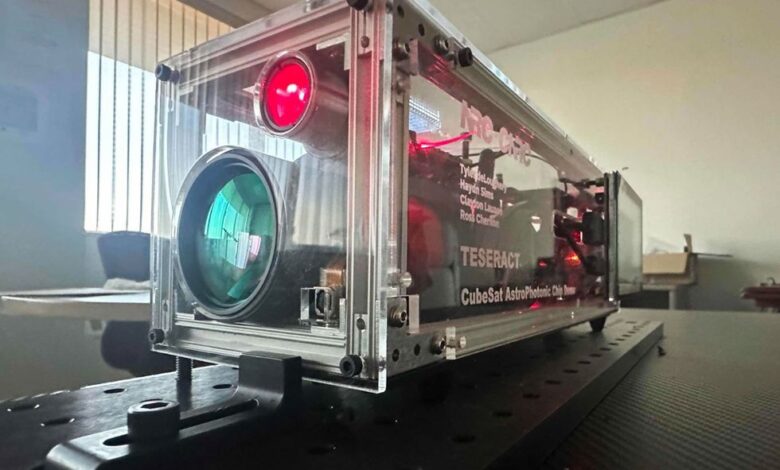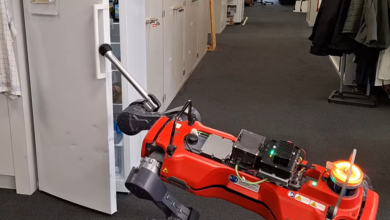Photonic Chip Cuts Cost of Hunting Exoplanets

At 6.5 meters in diameter, the James Webb Space Telescope’s primary mirror captures more light than any telescope that’s ever been launched from Earth. But not every astronomer has US $10 billion to spend on a space telescope. So to help bring the cost of space-based astronomy down, researchers at the National Research Council of Canada in Ottawa are working on a way to process starlight on a tiny optical chip. Ross Cheriton, a photonics researcher there, and his students built and tested a CubeSat prototype with a new kind of photonic chip. The goal is to lower the barrier to entry for astronomical science using swarms of lower-cost spacecraft.
“We hope to enable smaller space telescopes to do big science using highly compact instrument-on-chips,” Cheriton says, who is also affiliated with the Quantum and Nanotechnology Research Centre in Ottawa.
Photonics integrated circuits (PICs) use light instead of electricity to process information, and they’re in wide use slinging trillions and trillions of bits around data centers. But only recently have astronomers begun to examine how to use them to push the boundaries of what can be learned about the universe.
Ground-based telescopes are plagued by Earth’s atmosphere, where turbulence blurs incoming light, making it difficult to focus it onto a camera chip. In outer space, telescopes can peer at extremely faint objects in non-visible wavelengths without correcting for the impact of turbulence. That’s where Cheriton aims to boldly go with a PIC filter that detects very subtle gas signatures during an exoplanet “eclipse” called a transit.
The main motivation for putting photonic chips in space is to reduce the size, weight, and cost of components, because it can be produced en masse in a semiconductor foundry. “The dream is a purely fiber and chip-based instrument with no other optics,” says Cheriton. Replacing filters, lenses, and mirrors with a chip also improves stability and scalability compared to ordinary optical parts.
CubeSats—inexpensive, small, and standardized satellites—have proved to be a cost-effective way of deploying small instrument payloads. “The compact nature of PICs is a perfect match for CubeSats to study bright exoplanet systems James Webb doesn’t have time to stare at,” says Cheriton.
For a total mission cost of less than $1 million—compared to the Webb’s $10 billion—an eventual CubeSat mission could stare at a star for days to weeks while it waits for a planet to cross the field of view. Then, it would look for slight changes in the star’s spectrum that are associated with how the planet’s atmosphere absorbs light—telltale evidence of gasses of a biological origin.
Smaller spectroscopy
As a proof-of-concept, Cheriton guided a team of undergraduate students who spent eight months designing and integrating a PIC into a custom 3U CubeSat (10 centimeter x 10 cm x 30 cm) platform. Their silicon nitride photonic circuit sensor proved itself capable of detecting the absorption signatures of CO2 in incoming light.
In their design, light entering the CubeSat’s collimating lens gets focused into a fiber and then pushed to the photonic chip. It enters an etched set of waveguides that includes a ring resonator. Here, light having a specific set of wavelengths builds in intensity over multiple trips around the ring, and is then output to a detector. Because only a select few wavelengths constructively interfere—those chosen to match a gas’s absorption spectrum—the ring serves as a comb-like filter. After the light goes through the ring resonator, the signal from the waveguide gets passed to an output fiber and onto a camera connected to a Raspberry Pi computer for processing. A single pixel’s intensity therefore serves as a reading for a gas’s presence.
Light travels through a waveguide on a photonic integrated circuit.Teseract
Because it’s built on a chip, the sensor could be multiplexed for observing several objects or sense different gasses simultaneously. Additionally, all the light falling on a single pixel means that the signal is more sensitive than a traditional spectrometer, says Cheriton. Moreover, instead of hunting for peaks in a full spectrum, the technology looks for how well the absorption spectrum matches that of a specific gas, a more efficient process. “If something is in space, you don’t want to send gigabytes of data home if you don’t have to,” he says.
Space travel is still a long way off for the astrophotonic CubeSat. The current design does not use space-qualified components. But Cheriton’s students tested it in the lab for red light (635 nm) and CO2 in a gas cell. They used a “ground station” computer to transmit all commands and receive all results—and to monitor the photovoltaics and collect data from the flight control sensors onboard their CubeSat.
Next, the team plans to test whether their sensor can detect oxygen with the silicon nitride chip, a material that was chosen for its transparency to the gas’s 760 nm wavelength. Success would leave them well positioned to meet what Cheriton calls the next huge milestone for astronomers: looking for an earth-like planet with oxygen.
The work was presented at the Optica (formerly Optical Society of America) Advanced Photonics conference in July.
IEEE Spectrum



